 |
 |
 |
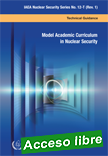 |
Model Academic Curriculum in Nuclear Security
IAEA Nuclear Security Series No. 12-T (Rev. 1) IAEA Nuclear Security Series No. 12-T (Rev. 1)
STI/PUB/1930 ¦ English ¦ 141 pages ¦ Date published: 2021
This publication provides a model academic curriculum covering the entire spectrum of nuclear security topics for a master’s degree programme or for an academic certificate programme in nuclear security. The first edition, entitled Educational Programmes in Nuclear Security, was published in 2010. Since then, the body of knowledge in the field of nuclear security has grown substantially and the IAEA Nuclear Security Series has expanded to cover more topics.
|
The current publication takes into account the latest IAEA guidance, as well as feedback from the International Nuclear Security Education Network (INSEN) community and other international experts. The publication can be used by university curriculum developers as well as faculty and instructors from institutions that are implementing or considering educational programmes in nuclear security.
|
 |
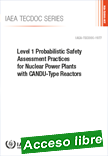 |
Level 1 Probabilistic Safety Assessment Practices for Nuclear Power Plants with CANDU-Type Reactors
IAEA TECDOC No. 1977 ¦ 128 pages ¦ Date published: 2021
This publication provides a comprehensive summary of experiences and results collected at a series of technical meetings of Member States currently operating CANDU-type nuclear power plants. Special emphasis is placed on supporting future harmonization in the regulatory framework, level 1 PSA methodologies and tools and level 1 PSA scope.
|
In addition, information is shared on actions undertaken in response to lessons learned from the Fukushima Daiichi accident.
|
 |
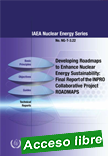 |
Developing Roadmaps to Enhance Nuclear Energy Sustainability: Final Report of the INPRO Collaborative Project ROADMAPS
IAEA Nuclear Energy Series NG-T-3.22
English ¦ STI/PUB/1941 ¦ 70 pages ¦ Date published: 2021
This publication introduces the concept of roadmapping for enhanced nuclear energy sustainability, which has been developed over the course of several collaborative projects within INPRO and presents the outputs of the INPRO collaborative project ROADMAPS.
|
Includes case studies of trial applications of the roadmap template conducted by experts from Member States and IAEA staff members working on INPRO. The studies address national or cooperative long term nuclear energy deployment scenarios with evolutionary and innovative nuclear energy technologies. This publication also provides examples of possible roadmap aggregation for analysis at regional and global levels.
|
 |
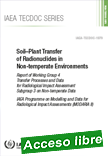 |
Soil–Plant Transfer of Radionuclides in Non-temperate Environments
Report of Working Group 4 Transfer Processes and Data for Radiological Impact Assessment Subgroup 3 on Non-temperate Data. IAEA Programme on Modelling and Data for Radiological Impact Assessments (MODARIA II)
IAEA-TECDOC-1979 ¦ English ¦ 96 pages ¦ 14 figures ¦ Date published: 2021
This publication considers radionuclide transfer in tropical and arid environments with a focus on root uptake by crops from soils.
|
The data collected and analysed are relevant for estimating the transfer of radionuclides through food chains to humans and for assessing radiation doses to the public due to intakes of these radionuclides in plant products used as food. The data relate to equilibrium conditions between the radionuclide’s dynamics into and out of the compartments of the environment and are appropriate for radiological environmental impact assessment in planned and existing exposure situations where such conditions have been established. Moreover, this publication classifies the data according to an international climate classification scheme and compares the summary values derived for tropical and arid environments with those presented in IAEA Technical Reports Series No. 472 for temperate environments.
|
 |
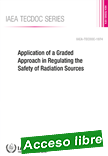 |
Application of a Graded Approach in Regulating the Safety of Radiation Sources
IAEA TECDOC No. 1974 ¦ English ¦ 106 pages ¦ Date published: 2021
A properly established governmental, legal and regulatory framework for safety provides for the effective regulatory control of facilities and activities with radiation sources. An important aspect of a regulatory framework is to ensure that the implementation of the regulatory programme is commensurate with the radiation risks associated with facilities and activities, in accordance with a graded approach.
|
This publication provides practical guidance on the application of a graded approach in regulating the safety of radiation sources. Examples of applying this approach in some Member States are included. The proposed methodologies promote a systematic and consistent approach to regulating in accordance with the IAEA safety standards.
|
 |
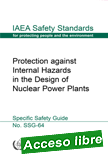 |
Protection against Internal Hazards in the Design of Nuclear Power Plants
IAEA Safety Standards Series No. SSG-64
STI/PUB/1947 ¦ English ¦ 83 pages ¦ Date published: 2021
Internal hazards have to be considered in the design of items important to safety in a nuclear power plant. The objective is to provide appropriate features to prevent internal hazards and mitigate their effects to ensure that safety is not compromised. This Safety Guide provides recommendations to regulatory bodies, nuclear power plant designers and licensees on hazard assessment (including for combinations of hazards) and design concepts for protection against internal hazards in nuclear power plants, in order to meet the requirements established in IAEA Safety Standards Series No. SSR 2/1 (Rev. 1), Safety of Nuclear Power Plants: Design.
|
The following internal hazards are reviewed in this Safety Guide: fires, explosions, missiles, pipe breaks, flooding, collapse of structures and falling objects with a focus on heavy load drop, electromagnetic interference and release of hazardous substances originating from within the site boundary.
|
 |
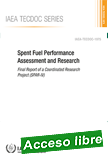 |
Spent Fuel Performance Assessment and Research
Final Report of a Coordinated Research Project (SPAR-IV)
IAEA TECDOC No. 1975 ¦ English ¦ 158 pages ¦ Date published: 2021
This publication is based on results obtained in the participating Member States during an IAEA coordinated research project (CRP) on spent fuel and storage system performance. It provides an overview of the technical issues related to wet and dry storage of spent fuel and summarizes the objectives and major findings of the research carried out within the framework of the CRP.
|
The experience and insights provided by the participants are expected to assist readers in identifying challenges in implementing long term storage and promote understanding of the current status of spent fuel performance research.
|
 |
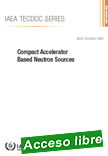 |
Compact Accelerator Based Neutron Sources
IAEA TECDOC No. 1981 ¦ English ¦ 124 pages ¦ Date published: 2021
The production of neutrons by accelerators began in the 1970s with construction of powerful proton accelerators to access neutrons via spallation. At the same time, low energy driven neutron processes emerged for neutron production using electron accelerators, ion beam accelerators, cyclotrons, and low energy linear accelerators. This wide variety of accelerator based neutron sources have come to be referred to as ‘compact accelerator based neutron sources’ (CANS).
|
This publication provides an overview of the various types of CANS technologies that are currently available or planned in the near future. It illustrates many of the analytical and other applications of neutrons. Given the wide variety of power and costs, the publication also aims to show that in addition to replacing national medium flux research reactors for certain functions, smaller regional neutron sources may become viable, which may eventually broaden access to neutron facilities.
|
 |
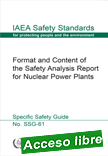 |
Format and Content of the Safety Analysis Report for Nuclear Power Plants
Specific Safety Guide
IAEA Safety Standards Series No. SSG-61 ¦ English ¦ STI/PUB/1884 ¦ 197 pages ¦ Date published: 2021
This Safety Guide provides recommendations on the structure and content of the safety analysis report to be submitted by the operating organization to the regulatory body for authorization of the siting, construction, commissioning, operation and decommissioning of a nuclear power plant. It is intended to facilitate both the development of the safety analysis report by the operating organization and the checking of its completeness and adequacy by the regulatory body.
|
The publication is a revision of IAEA Safety Standards Series No. GS-G-4.1, Format and Content of the Safety Analysis Report for Nuclear Power Plants, which it supersedes. The revision reflects feedback experience from the Fukushima Daiichi accident and the subsequent stress tests performed. It also describes good practices and experience from the use of safety analysis reports for newly built nuclear power plants in different States and informs on recent progress made in approaches to safety assessment.
|
 |
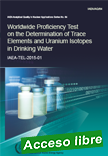 |
Worldwide Proficiency Test on the Determination of Trace Elements and Uranium Isotopes in Drinking Water
IAEA Analytical Quality in Nuclear Applications Series No. 64
IAEA-TEL-2015-01 ¦ English ¦ IAEA/AQ/64 ¦ 72 pages ¦ Date published: 2021
Reliable analytical results are crucial, as they are often the basis of decisions in the context of environmental or public health related issues, such as decisions concerning the safety of drinking water and required and suitable purification measures.
|
This publication presents the results of the worldwide proficiency test IAEA-TEL-2015-01 on the determination of selected trace elements and naturally occurring uranium isotopes in drinking water.
|
 |
| |
|
|

|
|
|
| |
|
|
| |
| |
|
|
| |
| |
|
|
| |
| |
|
|
|
| |
| |
